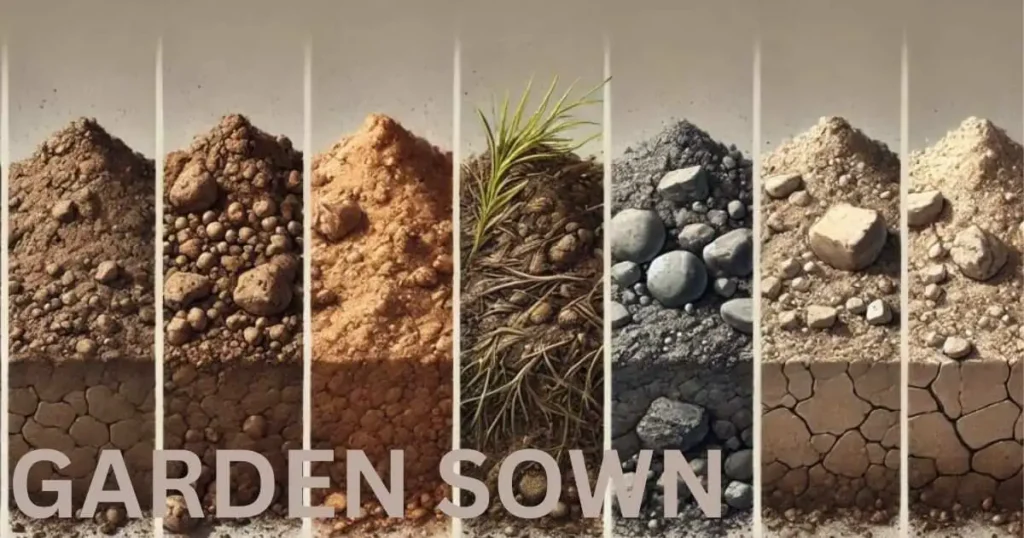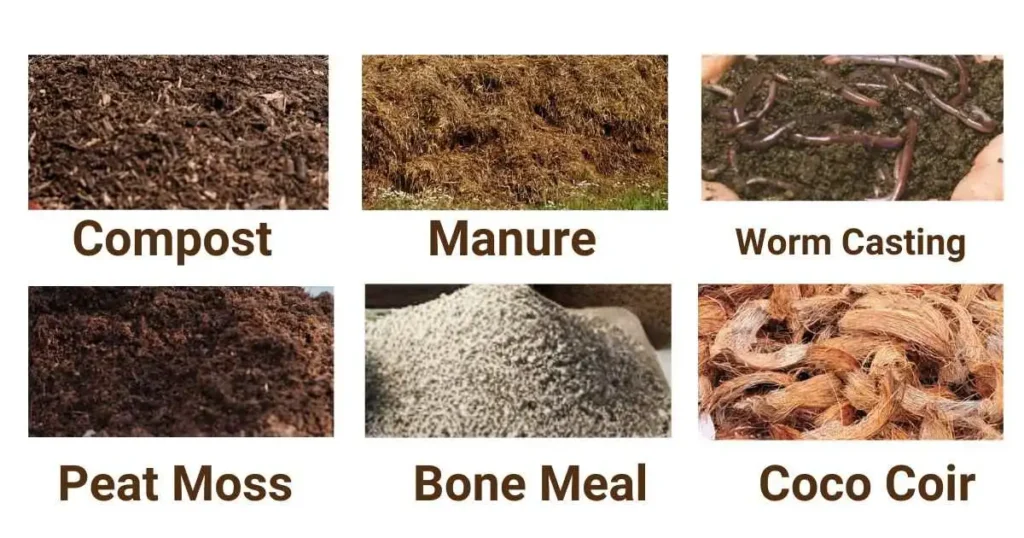Introduction: –
Any thriving garden relies heavily on its soil, the interface between the Earth’s geological and biological components. New gardeners who want to establish ideal growing conditions must thoroughly understand its different types. The kind of crops, bushes, and trees that can be effectively cultivated on a given land are largely determined by their minerals, organic, and inorganic components, significantly affecting plant health. Because it provides plants with all the essential nutrients, water, and air, necessary for their growth and development. Understanding your soil type allows you to improve its drainage, pH levels, and water retention, among other qualities.
06 Types of Soils for Plants

Soil is an essential part of life. We cannot produce nutritious food without healthy soil. For plants to flourish, it must be thick, airy, and nutrient-rich. By knowing its sort, farmers and gardeners select and successfully grow the crops or plants they want. To develop healthier plants, people can add compost, minerals, fertilizer, and water based on their soil type.
All garden soils can be divided into the following six main groups according to their composition, texture, and ability to retain nutrients.
- Loamy
- Clay
- Sandy
- Silty
- Peaty
- Chalky
| Soil Type | Color | Texture |
|---|---|---|
| Loamy | Dark brown to black | Fine-textured and slightly damp |
| Clay | Dark brown to Reddish Brown | Wet- Hard, and Dry- Sticky |
| Sandy | Grey to Light brown | Grainy |
| Silty | Light brown similar to sand | Smooth, soft texture |
| Peaty | Dark brown or Black | Spongy, soft |
| Chalky | Light brown to white-grey | Coarse, stony |
1- Loam Soil: The Ideal Gardener’s Choice:
Loam is often considered the best soil for gardening due to its balanced mix of clay, sand, and silt, making it nutrient-dense and well-draining. This composition makes it ideal for plant growth because it provides the characteristics of coarse sand, tiny silt, and clay particles.
Characteristics:
- Excellent water retention and drainage
- High in nutrients, supporting diverse plant growth.
- Well-aerated: loosely packed, letting oxygen flow through plants.
- Supports microbial life: that helps plants growth
- quickly warm up in the spring but slow to dry out in the summer
- Good root support: Allows plants to grow roots easily
- Ideal pH balance; because of its inorganic origins.
- Easy to work with
- Erosion-resistant
- Can roll up in a firm ball and fall apart easily when touching it.
Best For Plants:
Most vegetables, fruits, flowers, and herbs thrive in loam soil due to its balanced nature. Except for desert plants most plants like loam. Popular choices include tomatoes, roses, lettuce, carrots, onions, cucumbers, and squash.
Maintenance:-
While loam is ideal for plant growth, it can require some maintenance to ensure it remains nutrient-rich.
- Compost and organic materials like mulch and wood chips can assist in holding moisture and avoid drying out.
- Gardeners should maintain pH by testing and adjusting as needed. However, Rotating crops is one essential point to retain soil vitality.
2- Clay Soil-Rich Yet Challenging
Clay soil is dense, compact, and nutrient-rich. Compared to other soil types, it has the tiniest particles, which pack too closely with little to no airspace. This hinders the penetration of a plant’s fragile roots and makes it more difficult for water to sink. It is hard for gardeners to dig in and often presents challenges for them due to poor drainage and aeration.
Characteristics:
- High nutrient-holding capacity
- Retains moisture because composed of fine particles
- Poor drainage due to its composition
- Easily compacted
- Slow to warm in spring which can affect root health if not managed.
- Erodes slowly
- Cracks when dry
- Low aeration
- Poor root penetration
- Heavy to work with
Best For Plants:
Plants with strong root systems do well in clay soil. Examples include daffodils, asters, and certain shrubs like hydrangeas and dogwoods. Vegetables like broccoli and cabbages can also thrive.
Maintenance:-
- Adding organic matter, such as compost or peat moss, can improve aeration and drainage.
- avoid overwatering; add sand if needed.
- Using lighter soil from another location or planting mix
3- Sandy Soil: Well-draining but Nutrient-Poor
Sandy soil is composed of little fragments of worn rock that facilitate easy water drainage. It is among the worst types for plant growth because it contains very few nutrients and has a low ability to keep water, which makes it difficult for the plant’s roots to absorb it. It lacks humus, the dark-colored organic material in soil that provides nourishment to plants, giving it a lighter color.
Characteristics:
- Quick drainage
- Low nutrient retention due to poor organic matter holding capacity.
- Warms up quickly in spring
- Easily dries out
- Resistant to compaction
- Easy to work with
- Poor moisture retention
- Lightweight
- Quick to respond to fertilization
- May need frequent watering
Best For Plants:
Drought-tolerant, shrubs, bulbs, and deep-rooted plants do well, including lavender, rosemary, cacti, carrots, and radishes.
Maintenance:-
- Incorporating organic matter regularly
- Add Mulch to improve moisture retention
- Use slow-release fertilizers for nutrient availability
4- Silty Soil: Fine-textured and Moisture-Rich
Lakes, rivers, and other bodies of water are the primary locations for silty soil. It is made up of fine rock particles and organic materials that hold moisture better than sand but still provide better drainage than clay. Due to water holding capacity, It can be easily cultivated. It is easily transported by moving currents, and may also be prone to soil erosion in high-rainfall areas.
Characteristics
- Holds moisture well
- Rich in nutrients
- Erodes easily
- Prone to compaction, which may limit aeration and root growth
- Fine particles
- High microbial activity
- Medium drainage
- Can be sticky when wet
- Smooth texture, often described as ‘slippery’ when wet.
- Supports good plant growth
Best For Plants:
Excellent for moisture-loving plants such as iris, poppies, and willows. Many vegetables, like onions and carrots, also thrive in it.
Maintenance:-
- Adding coarse sand or organic matter can enhance its structure, preventing compaction and improving drainage.
- Preserve its structure by avoiding high foot traffic.
5- Peaty Soil: Acidic and Organic-Rich
Peaty soil is dark and soft. It is rich in decomposing organic material or plant remains, offering high moisture retention but often leaning toward acidic. High acidity slows down decomposition but can improve alkaline soil conditions for plants that require higher acidity levels, like blueberries.
Characteristics:
- High water retention; giving it a spongy texture
- Acidic pH
- Rich in organic matter
- Supports healthy microbial growth
- Naturally slow to decompose
- Holds nutrients well
- Low erosion risk
- Great for acid-loving plants
- Insulates roots well
- Stays cool
Best For Plants
Best for Acid-loving plants; Examples include azaleas, blueberries, and rhododendrons.
Maintenance:-
- Lime and other soil amendments can boost the pH
- Adding sand can enhance drainage
6- Chalky Soil: Alkaline and Nutrient Challenging
Compared to other soils, chalky soil has larger grains/ particles and is typically stonier. It is alkaline and contains calcium carbonate, which can hinder nutrient availability for many plants. It is common in high-altitude areas.
Characteristics:
- Alkaline pH
- Poor nutrient retention, due to the stony nature
- Drains well
- Can cause chlorosis (yellow leaves)
- May need frequent fertilization
- Rocky texture
- Limited moisture retention
- Dries quickly
- Low organic content
- High calcium content
Best For Plants:
Good for Alkaline-tolerant plants like lilacs, mock orange, and spinach.
Improving Chalky Soil:
- Adding organic matter and fertilizers can help improve nutrient availability, pH balance, and water retention but soil testing is essential for targeted amendments.
- Acidify with sulfur if needed;
- Add hummus to increase water retention
Soil Testing
Soil testing is a simple yet effective way to understand the pH, nutrient levels, and composition of your garden soil. Testing can be done using home DIY methods, test kits, or by sending samples to local agricultural extensions. Identifying your soil type can be done by examining its texture, color, and water retention capabilities. Here’s a quick DIY method:
Moisture Test/ Squeeze Test
Try to make a ball of wet soil, and examine its form and shape
| Soil Type | Test Results |
|---|---|
| Loam | loose ball, and retains shape for a short period. |
| Clay | firm ball, remains intact, and retains shape. |
| Sandy | Falls apart easily, won’t hold a shape. |
| Silty | smooth, slightly sticky ball, retaining its shape briefly. |
| Peaty | soft, spongy ball, that may retain its shape but feels lightweight and springy. |
| Chalky | Crumble apart, may not form a ball at all. |
Feel Test:
Rub the soil between your fingers and feel its texture:
| Soil Type | Test Results |
|---|---|
| Loam | smooth and slightly gritty |
| Clay | smooth and sticky |
| Sandy | rough and gritty, slipping easily through fingers |
| Silty | soft and silky, with a smooth texture |
| Peaty | spongy and moist |
| Chalky | coarse and gritty, with a dry texture |
The water test
Pour water onto your soil, and measure the time and distance
| Soil Type | Test Results |
|---|---|
| Loam | drains at a moderate rate, typically around 1 to 2 inches per hour |
| Clay | drains slowly, often less than 1 inch per hour |
| Sandy | drains very quickly, more than 2 inches per hour |
| Silty | drains moderately, slightly slower than loam, around 1 inch per hour |
| Peaty | drainage is slow due to high organic content, often forming puddles |
| Chalky | drains quickly due to coarse particles |
Settling Test:
Place a small soil sample in a jar with water, shake well, and give time to allow the layers to settle. The sedimentation pattern will reveal the proportions of sand, silt, and clay.
- Loam: Forms distinct layers in the jar, with sand settling at the bottom, silt in the middle, and clay on top
- Clay: Settling into a thin, dense layer at the top of the jar.
- Sandy: settles quickly at the bottom.
- Silty: Settles more slowly, creating a fine, smooth, compact layer just above any sand present.
- Peaty: Mostly floats or suspends in the water
- Chalky: Quickly settles at the bottom and often appears grainy or gritty, with visible white particles due to calcium content.
pH test:-
Take a soil sample. Split the sample in two, then put half of it in the jar. Pour water into the remainder of your container and shake for two minutes. Let the jar sit without touching it. Pour in a small amount of vinegar.
Results:
Alkaline one fizzes or bubbles. To be sure, hold the jar up to your ear and listen for a crackling sound.
If no reaction occurs, transfer the leftover the remaining sample to a second container. Fill the jar with water. Then sprinkle some baking soda on top.
Result:
Acidic one fizzes or bubbles. A cracking sound should be heard when you hold the Jar up to your ear.
Amending Based on Results:
- Acidic: use lime to increase pH.
- Alkaline: use sulfur to lower pH
- Organic compost improves nutrient content and structure across soil types.
Conclusion:
Understanding soil types and their unique properties is the cornerstone of successful gardening. Each type has strengths and challenges, requiring a tailored approach to maximize productivity and plant health. By testing and amending soil, gardeners can ensure their plants receive the nutrients and support they need to thrive in any environment. A well-tended garden begins with well-understood soil, making this knowledge invaluable for any green thumb.


